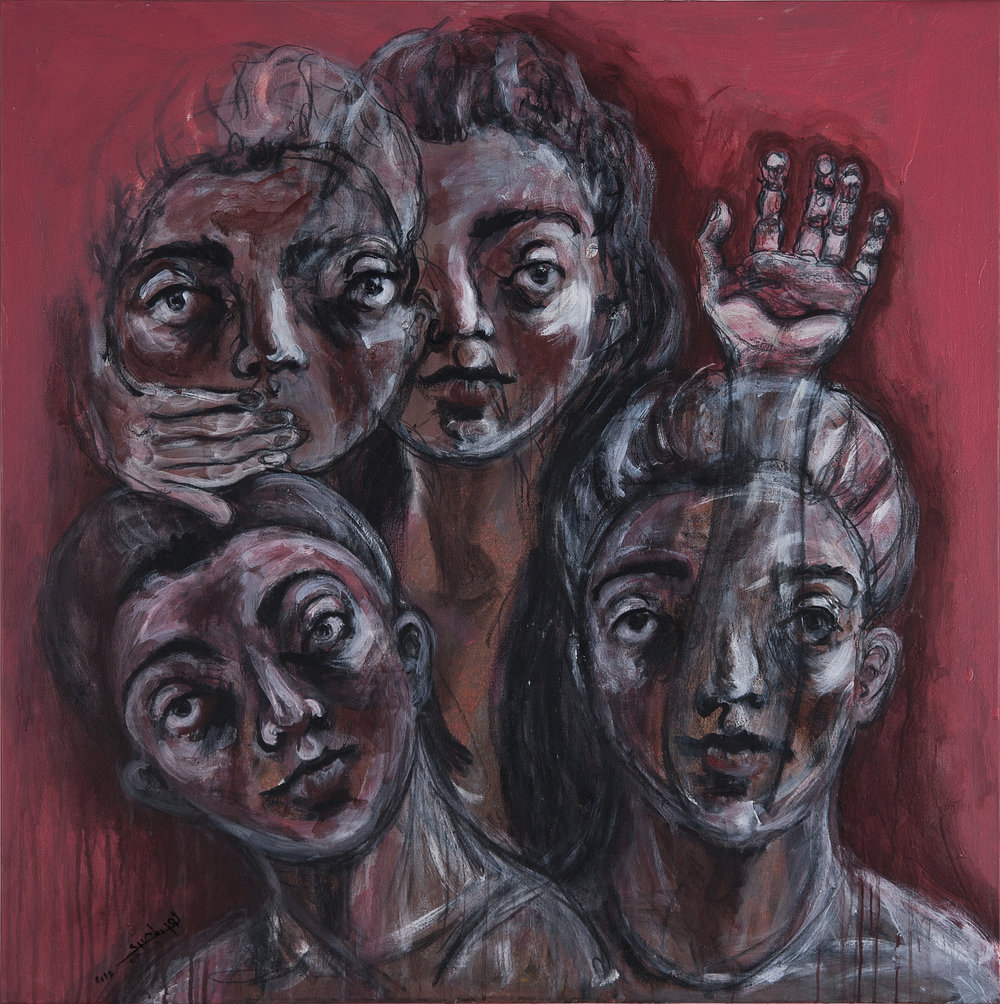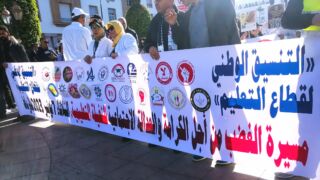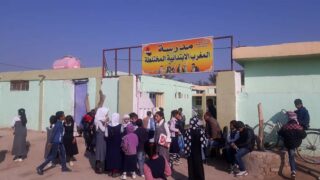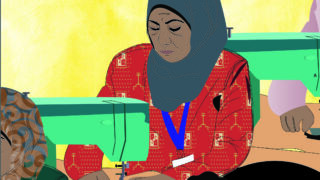
This publication has benefited from the support of the Rosa Luxemburg Foundation. This text may be reproduced in part or in full, provided the source is acknowledged.
Women tell endless stories, without being the heirs of Scheherazade, and without the presence of a man as powerful and tyrannous as Shahryar in their reality. Their stories come from within the spiral of disparities and the cycles of paradoxes in their lives, from the family to the school, university, job, street, mosque, or cyberspace... as though their femininity bore a concomitant shame, passed on from generation to generation. Since there is no escaping the sex they were born with, and as there is no turning back, they find themselves confronted by several choices from which they must select the lesser of evils.
Nothing is easy, ordinary or safe in a woman's life. On the contrary, everything engenders anxiety, fear and hesitation. “The other” does not look at the woman with satisfaction, and does not like that she is “female”. He; whether “he” is a person, a group of people, or society as a whole, blames her for all that he has suffered and continues to suffer. The rank of a woman, no matter how far she goes in her education or career, does not absolve her from the grind of discrepancies between how she should be living her life, and how it actually is.
Cultural heritage offers a history of Moroccan women and their lives; hence, we examine popular culture and its prejudices against women. Let us consider, for example, Moroccan proverbs as the mouthpiece of society. They promote phrases that tell us that it is impossible to rely on women in building communities, and particularly, families. One phrase is “The homes of women are soon desolate,” which means that women are considered a transient presence in the house; always subordinate to men, from the father to the husband. However, contemporary lifestyles have repeatedly proven this saying’s ineptitude, given the number of families in which the breadwinners are women. In 2020, the number exceeded one million families, with a rate of one out of six families being provided for by women. The number of families in Morocco in the same year reached more than eight million, according to the Ministry of Solidarity, Social Integration and the Family.
Great efforts were made leading to a victory for the “Sulaliyyate” women in 2019, when the Ministry of the Interior issued a statement stipulating the decision which recognized their right to “benefit from the communal lands”. However, some men still refuse to give the women their share of the inheritance.
It is true that other popular proverbs carry opposing connotations, such as “A man without a woman is like food without salt,” but the food is the main course and salt is merely a condiment; one which is indeed very important for the food to taste well, but, a condiment nevertheless. Perhaps it is sufficient to examine the contemporary reality in which Moroccan women have proven their viability, in order to expose the prejudice of these outdated proverbs. And, in spite of their long-evident capabilities, women still suffer from a great incongruity between what they receive in life and what the law has granted them. Moroccan law, despite its shortcomings in certain aspects, is considered one of the most advanced among Arab laws in terms of protecting women's rights.
The Family Code and the reality of divorced women
Impressive as the progressiveness of legal texts may be when it comes to women’s rights and their transcendence of the established reality, it is astounding that these laws have failed thus far from turning texts into applicable measures that can protect women's rights on the ground, rather than on paper. In our search for manifestations of the widening gap between law and reality, we start from the laws of divorce and marriage. Those laws cannot be applied without the “'Udûl” (the authorized officiant), and in most cases the courts do not interfere in cases related to family issues. However, as the structures of Moroccan society evolved, and with the amendment of the Family Code (on February 5, 2004), which provided additional rights for women, divorce proceedings were assigned to the jurisdiction of the family courts.
The three most common types of divorce in Morocco are: uncontested divorce; in which both spouses are in agreement regarding the termination of their relationship, according to the conditions which should not contradict the Family Code. Then, there is divorce by “Khula’”, which takes place when the two parties agree to separate, but are at odds with regard to the related procedures. In this case, the court has the authority to make a decision on the matter.
Contrary to what is known as “Khula’” divorce in other countries, where women give up their rights to be released from the marriage, there is no legal revocation of rights in Morocco, where women seek divorce and obtain their rights simultaneously. In Morocco, this is called “Shiqaq,” or discord divorce, and it is the third common type of divorce. This does not preclude the existence of cases in which women give up their rights to expedite divorce procedures when they know that the husband will stall in order to avoid granting them those rights.
In general, divorce in Morocco is no longer subject to religious provisions; it can only take place through legal procedures, and cannot be considered otherwise. A man and a woman must follow the same legal procedures when filing for divorce. The only difference is that the court asks the husband to deposit a sufficient amount of money in the court fund to cover the alimony and child support. This is a mandatory condition before the two parties can notarize their divorce by two “'Udûl” (civil officiants who replace the “Ma’zoun”; i.e. the religious officiant who previously had this authority).
In other cases, the solution is judicial divorce, wherein the judge determines the divorce procedures based on the laws of the Family Code, for the lack of an agreement between the two concerned parties. According to the statistics of the Ministry of Justice in 2020, uncontested divorce cases made up 80 percent of all divorce cases. And, although it is somewhat easy for Moroccan women to obtain a divorce, obtaining their rights within the divorce is a totally different, more complicated, matter.
Impressive as the progressiveness of legal texts may be when it comes to women’s rights and their transcendence of the established reality, it is astounding that these laws have failed thus far from turning texts into applicable measures that can effectively protect women's rights. However, the amendment of the Family Code on February 5, 2004, has provided additional rights for women, as family courts became responsible for legal divorce proceedings.
Those include her rights and the rights of her children, whose custody is granted to the mother by the Family Code. The woman loses the right to custody in the event of her marriage to another man after the divorce (save in some specific cases), upon which, the father becomes entitled to custody, unless he remains silent for a year after learning about the remarriage, at which time his custody is forfeited. Generally speaking, most men tend to neglect their children after a divorce, while forgoing child support in order to focus on starting a new family. The judge can make an estimation of the due child support, based on the father’s monthly income. In most cases, the amount specified by the judge insufficient; still, most fathers try to evade paying child support.
The issue of inheritance is also brought up sporadically for public debate, as it is often overlooked because of society’s resistance to it. The family is at the heart of this matter. When a father who has no sons passes away, the paternal uncles share the inheritance with the deceased’s daughters. The house is usually sold, and its proceeds are distributed among the heirs. Hence, the daughters - and even the wife – find themselves without a roof over their heads. Perhaps the battle of the “Sulaliyyate” (“lineage”) women is evidence of the possibility of effecting change in this reality. These women come from tribes that consider that their marriage to men from outside the tribe compromises their right to the land of their fathers. Those tribal lands are owned by a group of people related by familial kinship or who are of the same lineage, and are managed according to custom by the heads of the families that comprise the group. Great efforts were made leading to a victory for the “Sulaliyyates” in 2019, when the Ministry of the Interior issued a statement stipulating the decision which recognized their right to “benefit from the communal lands”. However, some men still refuse to give them their share of the inheritance.
Child marriage and polygamy: The judge overshadows the law
Although the law prohibits polygamy and child marriage, it leaves some room for a few exceptions, upon the permission of a judge. However, these “few” exceptions multiply in real life, wherein child marriage for girls is frequent and polygamy is an established practice either through the circumvention of the law, by pressuring the first wife, or by bribing officials. In 2020, underage marriages made up 7 percent of all marriage contracts in the country, according to the Ministry of Justice. Another indicator of child marriage is the annual fertility rate, which revealed that girls aged 15 to 19 accounted for nearly 20 percent of the total births in 2018, according to the Ministry of Health. On the other hand, the percentage of polygamous marriages comprised 0.3 percent of all marriage contracts in 2020, let alone the cases of defrauding through obtaining a certificate of celibacy from a city other than that where the first wife resides and in which the first marriage was registered, in collusion with some employees at the Ministry of the Interior, or by threatening the first wife with divorce, especially if she were infertile.
The first wife, fearing the prospect of ending up on the street, is coerced to consent to the polygamous marriage. Not only this; the husband often brings the second wife into the house, where both wives have to cohabitate under the same roof. Polygamy is not only for the wealthy, as in many cases, men with low incomes, who cannot afford to provide independent housing for each wife, also arrange for both wives to live in one apartment.
Violence and sexual harassment… Collective waivers
Statistics show that more than half of Moroccan women are subjected to at least one form of violence. During 2019, more than 7 million women, that is, 57 percent of women, experienced at least one form of violence. Marital relationships remain the most violent, with psychological abuse being its most common form, making up 46 percent of all cases of abuse, that is, 5 million women. Educational spaces come in the second place, with 22 percent of female students subjected to a form of abuse. As for the professional sector, the percentage of women who are abused during the course of their work reached 15 percent of working women. Whereas, about 13 percent of women were exposed to some form of violence in the street or in public spaces.
They say the presence of girls in their families is “transient”? But the number of families for which women provide has exceeded one million families in 2020, with a rate of one out of six families. The number of families in Morocco in the same year reached more than eight million. In fact, the salaries of young working women benefit their parents and siblings, whereas men tend to be preoccupied with living independently, enjoying life, and preparing to start a new family.
Even though sexual harassment is criminalized, the law remains difficult to implement, especially since its definition of sexual harassment is somewhat ambiguous. It raises questions such as: Must an incident include sexual language in order to be termed “sexual harassment”? What about women who receive unwanted flirtation and are stalked in the street? Which laws can they resort to? Furthermore, making incidents of violence public is not always easy, and perhaps this represents one of the most dangerous aspects of violence, as women sometimes choose not to share what had happened, either out of fear of being discredited, punished or shamed because of their experiences.
In a recent incident in Morocco, the body of a girl was assaulted and exposed in the street. The crime was documented, thus causing an uproar in public opinion. Following the arrest of the perpetrators, the victim dropped the law suit after interventions were made, which led to receiving a financial settlement instead. This incident raises questions about the issue of protecting girls from the interference of their families in order to circumvent the repercussions of the crimes. However, who shields women from the psychological trauma after they drop their rights in the courts of law? What is the law that should be in place to convince the victim - or her family, rather, not to waive these rights, since the family usually takes over the responsibility of managing the victim's case and following up the legal procedures? Often, the family takes the settlement money, while the victim alone suffers from the post-traumatic effects of the crime, and the perpetrator roams free.
Academic excellence and a weak presence in the labor market
The figures show a significant increase in the rates of girls and young women in education facilities. They also show that girls outperform boys in schools. However, we are yet to see a substantial presence of women in the labor market, as most of them are unemployed or underemployed, which means that they practice marginal professions, for which they are overqualified. Statistics show that the rate of completing an educational level reached 97 percent for girls in primary school in 2019, whereas it was 93 percent for boys in the same year. However, in the secondary level, only 53 percent of girls complete their studies, which means that almost half of them are never promoted to the Baccalaureate year (or senior year). On the other hand, we note that the percentage of schooled girls is still better than that of boys, which make up a mere 38 percent of all school students. Despite a clear outnumbering for the girls in those rates, as opposed to the previously prevalent, lower rates, the reasons for dropping out of school are often family-related. Young women leave school to help their families with housework or in agricultural labor in the villages, and a certain percentage of them drops out for marriage; whereas half of the young men drop out of school for other reasons, such as finding work, of course, or because they did not get along well in school, or because of learning difficulties.
Divorce in Morocco is no longer subject to religious provisions. It can only take place through legal procedures, by which a man and a woman must follow the same legal proceedings when filing for divorce. The only difference is that the court asks the husband to deposit a sufficient amount of money at court, to cover the alimony and child support, as a mandatory condition before the divorce is verified. In 2020, the percentage of uncontested divorce cases reached 80 percent of all divorces.
Working women constitute 20 percent of the total workforce in Morocco, and, in order to understand the weight of the responsibility they hold, we note that the statistics divulge that 43 percent of working women are divorced, as per the figures issued recently by the “High Commission for Planning” (HCP) in its report on the situation of women in Morocco in the year 2020. This is accounted for by the overall high divorce rates, together with the dipping remarriage rates for divorced women, especially for those who have children. In addition, a certain percentage of divorced women were not part of the labor force during their marriages and were forced to work after their separation in whatever elementary occupations they could find, because they lack higher education degrees. Nevertheless, observations show that women are generally more responsible for their families than men, as the salaries of young women benefit their parents and siblings, whereas men tend to be preoccupied with living independently, enjoying life, and preparing to start a new family.
The number of girls and young women in higher education has notably increased, reaching 52 percent of all students in 2019, compared to 42 percent in 2016. In educational fields of limited polarization, such as engineering and medicine, an increase is also detected. In 2019, female students made up 67 percent of medicine and pharmaceutical studies’ students, 73 percent of dentistry students, 59 percent of science and technology students, and 60 percent of commerce and management students. This outnumbering is not mirrored in the labor market, due to the fact that these percentages are recent and have not yet moved from the academic spaces to the workforce.
World Bank experts have released a report analyzing the reasons for the poor participation of Moroccan women in the labor market. The report concluded that the rate is among the lowest in the world, despite the high GDP per capita, low fertility rates, and improved chances of education. Thus, Morocco occupies the 180th place out of 189 countries, as 78 percent of Moroccan females aged 15 to 65 do not work or are not looking for work.
According to the World Bank experts, Morocco has two distinct labor markets. The first market is in urban areas, where the rates of employment and participation of both genders in the labor force are high, and the second is in rural areas, where the rate of women’s unpaid labor inflates, knowing that most work available in the rural regions is almost confined to daily-wage agricultural labor in the large villages. A portion of them work in agricultural cooperatives that are classified as part of solidarity economy, or as family economy. Analysts explain that the better educated the male provider in the family is, the more likely the women of the family will remain outside the labor force. Moreover, marriage limits the possibility of entering the work force, and the traditional stances towards working women contribute to perpetuating this situation.
At the level of elementary occupations, in which working hours and wages vary to a great extent, we note that factories have a preference for female workers over male workers, because the former can be more easily exploited. Not only are they given low wages, but they also do not benefit from any employment rights. In 2020, women’s presence in the economic sectors amounted to more than 31 percent in agriculture and fishing, 25 percent in industry - including traditional industries, and 19 percent in the service sector.
Working women constitute 20 percent of the total workforce in Morocco, and, in order to understand the extent of the responsibility they hold, we note the statistics that state that 43 percent of working women in the year 2020 are divorcées. This is accounted for by the overall high divorce rates, together with the dipping remarriage rates for divorced women, especially those who have children.
We note not just the meagerness of wages, but rather the lack thereof. 35 percent of active women work without pay. Their work includes domestic labor, taking care of the family, parents and household, or helping the father or the husband in their small family businesses, where the women often receive zero wages. The report of the “High Commission for Planning” (HCP) indicates that women who have jobs outside their households, continue to bear the burden of domestic work for a minimum of 4 hours per day.
Women in official positions: The tree that hides the forest
What about women in decision-making positions? It may seem that the appointment of 7 women ministers in the new Moroccan government (they became 6 a few days later) is a big positive step in this direction, but, in reality, it is not, as most of these ministers do not head influential ministries. Given their education abroad, their partisan affiliations and their detachment from the poorest groups, and based on previous known experiences, it is not expected that they will make any real changes regarding women’s rights to equality or in narrowing the gaps between women and men in Morocco, whether through their decision-making, or in providing additional value to the political presence of women in government positions. As for the numbers, statistics show that the percentage of women elected in 2020 as members of the legislative body did not exceed 13 percent. Nonetheless, the percentage of women ministers in 2021 reached 29 percent, which indicates a remarkable progress on a quantitative level. Be that as it may, the numbers do not necessarily reflect a meaningful change in the political map in terms of gender representation.
As for parliamentary elections, women won 24 percent of the Parliament seats in 2020. When compared to the percentage of female candidates that year, which reached 34 percent, it can be deduced that the voting body did not trust a significant part of them, while voting for 76 percent of the male candidates, who comprised 66 percent of the total number of candidates. Note that the percentage of women who won seats in Parliament is partly included in the “quota” system in the first place. In other words, a significant percentage of them competed among themselves for seats which are previously reserved for women, while merely two of them won their seats based on mixed gender lists.
According to the Ministry of Interior, the percentage of women in legal and official positions in public administrations in 2019 is 24 percent as heads of authorities, 15 percent as heads of departments, and 12 percent as directors. The latter is the second highest position in any Moroccan ministry, right under the authority of the minister. Based on these percentages, one can infer the poor progress of women on the career ladder in comparison to men. In fact, quantitative progress does not always reflect a strong presence for women. For instance, the presence of women in diplomatic corps does not exceed 25 percent, yet women in these official bodies rarely stand out.
Religious “scholar councils” (which supervise religious affairs together with the concerned ministry) included 96 women and 592 men in 2020, according to the Ministry of Endowments and Islamic Affairs. This means that a major disparity persists in the religious presence of women in a religious society, and in the councils that are responsible for overseeing Friday sermons in mosques and supervising religious education in all regions, despite the fact that the presence of women in such councils is essential to enhance society's views of them, by ensuring that women's rights are respected in religious sermons and in fatwas. Women have the same responsibilities as men in these councils, save for the Friday sermon, which is recited almost always by men, while the women are entrusted with the tasks of preaching and guiding the girls, as well as giving literacy lessons in mosques.
Even though sexual harassment is criminalized, the law remains difficult to implement, especially since its definition of sexual harassment is somewhat ambiguous. It raises questions such as: Must an incident include sexual language in order to be termed “sexual harassment”? What about women who receive unwanted flirtation and are stalked in the street? Which laws can they resort to? Furthermore, making incidents of violence public is not always easy, and perhaps this represents one of the most dangerous aspects of violence.
In 2020, the percentage of female judges reached nearly 25 percent in Morocco. Nearly 24 percent of lawyers in the country in 2020 were female; slightly higher than their percentage in 2010, which was 20 percent. In other words, in the span of ten years, the number of female lawyers increased by only 4 percent, according to the statistics of the Ministry of Justice. Furthermore, women who head contracting firms and companies constitute only 12 percent, according to 2019 statistics, bearing in mind that most of those companies are very small contractors.
In short, it is possible to judge the well-being of a given society based on the extent of women’s presence and their role in its labor market. Women benefit from their work in several ways that exceed the financial outcomes, through gaining moral satisfaction, receiving appreciation for their economic contributions within the family, having the ability to make decisions in the household, and becoming exceedingly independent as a result. Naturally, women’s status and autonomy are better reinforced by steady job experiences, and by jobs that are related to their professional training and chosen careers. On the other hand, the female workers in factories and in agriculture occupy a lower position, due to the lack of steady work and low incomes, which deprives them of a sense of job security, and limits their participation in decision-making within their families.
Imposed singlehood: Disparity in the right to have a partner
The manifestations of disparity between women and men are numerous, and they are not confined to the practical aspects of life. For a significant number of women, society does not respond well to their right to marry, start a family, and have a partner. The law has nothing to do with these cases, as the matter has to do with social awareness and changing society's views of women in every age and social condition.
Statistics issued by the “High Commission for Planning” (HCP) for the year 2020, indicate that the proportion of 65-year-old women who live by themselves exceeds 65 percent, while the percentage is only 3 percent for the women aged 30. This is because young women are not allowed to live independently, while society sees no problem with letting the elderly live alone. Most widowed and divorced women do not remarry and end up alone, whereas divorced and widowed men who remain single make up a mere 16 percent in that same age group. The percentage of women widows over the age of 60, who did not remarry, is 91 percent, while that of widowed men who remained single of that age group is only 8 percent!
The content of this publication is the sole responsibility of Assafir Al-Arabi and Rosa Luxemburg Foundation cannot accept any liability for it.
Translated from Arabic by Yasmine Haj
Published in Assafir Al-Arabi on 02/01/2022






